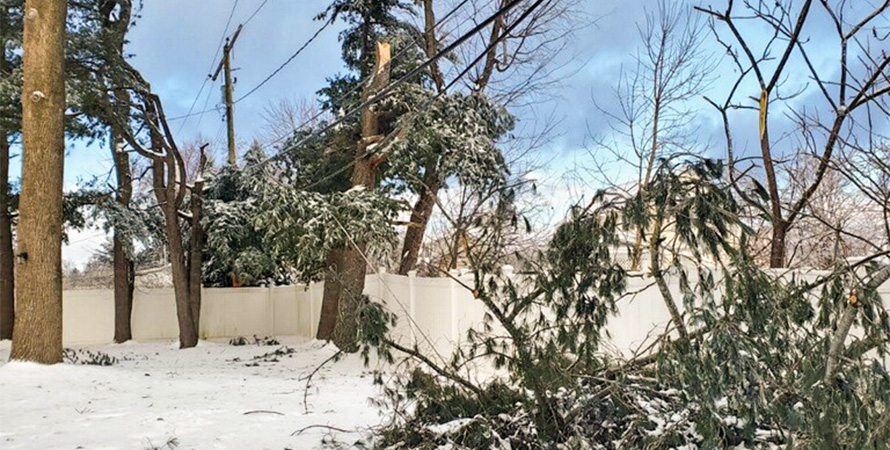National Grid Restores Power to More Than 71,000 Upstate New York Customers Impacted by Ongoing Winter Storm
Categories:

More than 2,400 line, service, tree, damage assessment and public safety workers are active across National Grid’s Upstate New York service area as severe weather — with wind gusts up to 65 mph in some areas — continues to hover over the region. The company’s field force has been working around the clock, clearing broken trees and tree limbs, and replacing downed wires, transformers, broken poles and other damaged equipment. As of 2:30 p.m., 71,250 of nearly 82,500 impacted customers have had service restored.
Company crews are facing heavy snowfall, gale-force winds, below-freezing temperatures and unsafe travel conditions, including impassable and closed roads. These conditions are expected to continue for the next few days.
“Safety remains the top priority for our employees and our customers,” said Matt Barnett, National Grid’s Chief Operating Officer for New York Electric. “This is an ongoing, dangerous storm. Our crews will continue to work around the clock to assess new damage, clean up extensive debris, and restore service where it is safe to do so.”
Barnett said the company is working closely with local officials, first responders, and other key emergency response personnel to coordinate restoration efforts. In anticipation of the storm, the company secured external resources from Canada, Connecticut, Massachusetts, New Jersey and Rhode Island to assist National Grid’s internal crews.
Regions hardest hit by the storm include Albany, Fulton, Oswego, Saratoga, Schenectady, Warren and Washington counties.
The Restoration Process
When it is safe to do so, the company’s first priority is to ensure the safety of our customers and our crews by clearing away dangers such as live, downed power lines. Next come repairs to the facilities that serve the largest number of customers such as main transmission facilities, followed by recovery work at local substations and repairs to neighborhood circuits, transformers and service wires. Click here to learn more about the company’s restoration process.
Estimated Restoration Times
- In the early stages of a storm, restoration times on National Grid’s Outage Central site may be listed as “assessing conditions.” This is because debris, such as trees, tree limbs, and downed wires, must be cleared away so that infrastructure damage can be assessed and restoration plans can be executed.
- It's normal for outage numbers and ETRs to fluctuate. The numbers can go up and down as lines are de-energize to make conditions safe for repairs. Additionally, there could be new outages that occur as the strong, damaging winds and snow continue.
- Outage Central Reminder: Our Outage Central page shows the estimated time of restoration for communities, and reflects the estimated time for the last customer in that community to have power restored. The most accurate way for customers to check on the power restoration estimate for their specific address is to log into our Report or Check Outage page.
Electricity & Generator Safety
- If a power outage occurs, customers can notify National Grid online to expedite restoration.
- Generators used to supply power during an outage must be operated outdoors to prevent the buildup of deadly carbon monoxide. Before operating a generator, be sure to disconnect from National Grid’s system by shutting off the main breaker, located in the electric service panel. Failure to do this could endanger our crews and your neighbors.
- Customers who depend on electrically powered life support equipment, such as a respirator, should register as a life support customer by calling National Grid at 1-800-642-4272. In a medical emergency, always dial 911.
- Stay tuned to local news outlets or the National Weather Service for storm updates, weather alerts
- Keep working flashlights and an extra supply of batteries in your home and be sure to charge all electronic devices.
- If the power is out, use flashlights or other battery-powered lights. Do not use candles, which can pose a fire hazard.
- Please use caution when driving near emergency responders and crews restoring power.
- Be sure to check on elderly family members, neighbors and others who may need assistance during an outage.
Safety Near Downed Power Lines
- Always use extreme caution near downed power lines and wires, and always assume that they are carrying live electricity.
- Never touch a person or an object that is in contact with a downed line, as electricity can pass through to you.
- Take caution when approaching fallen trees, which could have power lines caught in them.
- Remember that water can conduct electricity. If you see a line down in a puddle or flooded area, avoid contact with the water to prevent risk of shock.
Learn more about downed power line safety on our website.
About National Grid
National Grid (NYSE: NGG) is an electricity, natural gas, and clean energy delivery company serving more than 20 million people through our networks in New York and Massachusetts. National Grid is focused on building a smarter, stronger, cleaner energy future — transforming our networks with more reliable and resilient energy solutions to meet state climate goals and reduce greenhouse gas emissions.
Media Contacts
Related News
